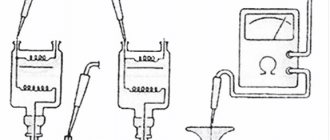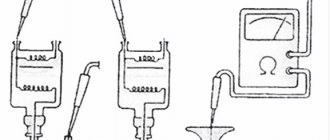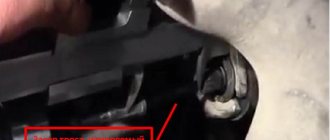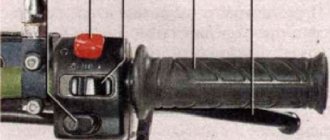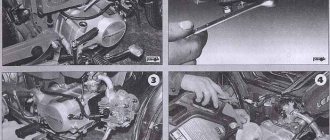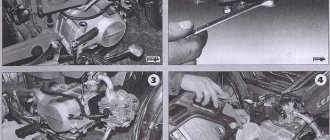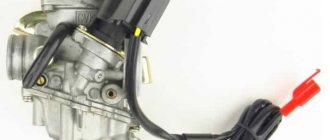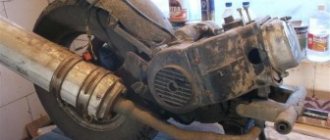Sometimes it happens that the carburetor starts to malfunction on a faithful iron horse and it becomes necessary to clean it and adjust it correctly. Symptoms of this problem most often include: difficulty starting the engine after long periods of standstill (1 day or more), power failures when switching from idle to load, and unstable engine operation at high speeds. And, as a rule, there is not always time or opportunity to roll the moped to a workshop where it could be repaired. Therefore, you have to take on this painstaking work yourself.
Signs of a carburetor malfunction
There is a situation when the carburetor of an Alpha moped starts to malfunction. This problem can be noticed during the operation of the vehicle. Symptoms of malfunctions are listed below:
- unstable operation at high speeds;
- loss of power when switching from idle to normal;
- Difficulty starting the engine after being idle for several days.
If you find one of the listed problems, you can try to clean it yourself and make adjustments. If this is not done, over time the engine will stop starting.
Soot contamination
Type of spark plug: dry soft soot of intense black color on the insulator, electrodes and spark plug body.
Consequences: poor start of the scooter engine; poor operation of a cold scooter engine; interruptions in ignition of the air-fuel mixture; bad reaction to gas.
Probable causes: excessively rich air-fuel mixture; The scooter's air filter is very clogged; The thermal range is incorrectly selected - the candle is too “cold”.
Remedy: adjust the working mixture; adjust the cold start system of the scooter engine; change the scooter air filter; clean the spark plugs or replace them with new ones - with the correct heat rating.
The design and principle of operation of the carburetor
The carburetor is the most important part of a gasoline engine. Its function is to prepare a mixture of fuel and air, saturating the fuel with oxygen. Next, this mixture is sent to the cylinders, where the gasoline should burn with the greatest efficiency. The moment air moves through the narrowing of the carburetor air throat, a decrease in pressure occurs. Due to this, fuel is sucked in.
Appearance of a moped carburetor
The properties of the mixture of fuel and air are controlled by the quality screw. The more it is twisted, the narrower the air channel, and the mixture becomes richer, that is, it contains more gasoline. If the screw is unscrewed, the oxygen concentration increases and the mixture becomes leaner. The carburetor must be adjusted correctly. Otherwise, it will become more difficult to switch from idle to operating speeds, and “dips” will begin when changing the throttle. The adjustment can be entrusted to professionals, but it is also not difficult to do it yourself.
Three jets are visible on the carburetor body; only the top two are used for adjustment. The idle jet located on the right is adjusted first. It is necessary when parked, when traveling in neutral or idling.
Screws required to adjust the carburetor on an Alpha moped
When the left fuel quality jet is not adjusted correctly, the mixture will be rich or lean. As a result, wear and fuel consumption increases. The lower jet is necessary to drain gasoline and remove condensate; it unwinds counterclockwise. But you don’t need to touch it to adjust it.
Comments • 50
But if I have a wels alpha zs125-12 moped, then it’s poorly written
Does that mean you have to change position every time you ride?
Yes, you can leave it open all the time, nothing bad will happen
Is this the same on all motorcycles?
I don’t understand, tell me they say differently: top reserve or bottom reserve. The arrow itself on the edges should not be up or something, if not in reserve, or something down.
I've never ridden on reserve, I'll have to try it.
Respect I was looking for this video for a long time
What to do if there is gasoline, you turn on the fuel tap and the fuel does not flow, but the reserve level is normal
How to start it after switching to reserve? Will it start immediately from the starter?
Source
Carburetor Adjustment Tools
It is necessary to prepare a screwdriver with a flat head, with which you will unscrew the bolts. If you have to remove the carburetor to clean it, you will need a 10mm wrench. You will also need a carburetor cleaner. It is available in aerosol form. The cleaner is very caustic, so it is advisable to purchase rubber gloves when working with it.
Carburetor cleaner
Results
Despite all the difficulties and apparent complexity of the device, adjusting the carburetor on a scooter is possible both at home and in the field. It is recommended to carry it out at least once a season, especially during frosts - this will avoid flooding the candle. If your old engine starts to feel bad, adjusting the carburetor can extend its life. Although the moped will lose a little power. And yet, with the help of proper carburetor settings, you can make life much easier for yourself and your iron horse.
How to clean the carburetor on a moped - step-by-step instructions
Cleaning is necessary if a lot of dirt and condensation has accumulated. To ensure that this procedure is not necessary, it is advisable to disconnect and disassemble the carburetor. If it is clogged, it is useless to perform adjustments.
First, turn off the fuel supply valve, then you need to disconnect the fuel and drain hoses from the carburetor.
Next, you need to disconnect the inlet pipe from the carburetor, then unscrew the throttle valve cover and remove it from the carburetor. Now the part is held in place only by two bolts, which can be unscrewed with a 10mm wrench. That’s it, the carburetor has been removed. It is advisable to disassemble it on a white table so as not to lose small parts.
Next you need to disassemble the carburetor. First, unscrew the bolts located on the carburetor body. After this, the protective cover will be removed.
Next, the float chamber is pulled out; it is held on one pin, which is removed from the grooves. It can be removed without using tools. Together with the camera, a small cylindrical part with a cone-shaped tip will be removed - a shut-off needle, which is held between the float and the fuel supply channel. It is important to make sure that it does not fall on the floor and get lost.
Now, using a screwdriver with a straight bit, unscrew the jets, the idle speed adjustment bolt and the mixture quality screw.
The unit is disassembled, you can proceed to cleaning. First, attach the tube attachment to the aerosol canister for cleaning.
The accumulated liquid is poured out of the carburetor cap, then the internal cavity is treated with a cleaning aerosol. The jets are treated in the same way; the aerosol tube can be lowered into the recesses and holes. Then all the internal cavities will be cleaned, and all the accumulated dirt will come out. An aerosol with a nozzle can be used to treat all other carburetor openings.
Small holes need to be blown out so that there is no dirt there. The cleaned parts are wiped dry with a cloth; it is important to wait until the applied aerosol has completely dried. Then reassemble the carburetor in reverse order. It is difficult to make a mistake during assembly, since all the parts differ in size and are placed only in certain holes.
Disassembled carburetor of an Alpha moped
When installing a float chamber, first attach an element that shuts off the fuel supply through the hole near the jets. A pin is connected to the camera mount, after which the entire structure is placed on the socket. Next, the cover is mounted and the bolts are tightened. Tighten the mixture quality screw one and a half turns, then tighten the idle speed screw.
It is recommended to spray the assembled carburetor to keep it clean on the outside. Next, the part is put in its original place, first the fuel hose is connected. Then you need to open the fuel valve and wait a few seconds until the fuel fills. You can now start the engine, but it may not start or may be too loud. This means that adjustment is necessary.
You can learn more about how to clean the carburetor on an Alpha moped from this useful video:
Fuel supply in a Chinese moped
First (just in case), check the air leak between the head and the pipe.
And read it so you can understand what’s what.
The principle of operation of the carburetor of a scooter, moped.
So, let's consider the basic principle of operation of the carburetor of all models of scooters with a carburetor power system.
The air that is supplied to the carburetor passes through a special tube, which gradually narrows towards the center, creating a low pressure zone in its center. the mixture is then supplied to the intake manifold, and from there to the engine. Thanks to the width of this tube, the air pressure is regulated, and, accordingly, the fuel is powerfully sucked out of the float chamber. By properly selecting the diameter of the diffuser and main jet, we get an ideal machine for supplying fuel to the combustion chamber. As the engine volume increases, it needs larger volumes of mixture, and accordingly the dimensions of the diffuser and main jet increase. As can be seen in the figure, fuel is discharged from the bottom to the top thanks to the vacuum that is created in the carburetor channel, and absolutely no additional devices are needed to supply fuel. This simple mechanism is very reliable and lends itself to many adjustments.
But in order for the engine to operate at the power we set, it is important to regulate the fuel supply. By simply blocking both the air channel and the tube itself, through which gasoline is sucked out of the float chamber, we increase or decrease engine power, which affects the speed. We control this using the gas handle, which in turn raises or lowers the throttle valve, or, more simply, the needle.
In Figure 2 we see the carburetor channel with the throttle valve installed. It cuts off the air and fuel supply at the same time. The needle has a cone-shaped shape, and when you turn the throttle, it gradually opens the fuel channel, while raising the air damper.
In Figure 3 you can see that the needle, rising upward, opens up a place for fuel to exit in a circle around it, opening the channel almost completely with the gas handle turned out to the maximum. Idling. The principle of idle speed on a scooter.
The principle of idle operation is very similar to the main one. This is a kind of miniature carburetor within a carburetor. In Fig. 2 shows that the damper in the lowered position does not completely block the air channel, leaving a small flow. It is needed for idle speed, which prevents the scooter engine from stopping during a temporary stop when you do not turn off the engine. After all, the main fuel channel is closed, where is gasoline supplied to the combustion chamber?
In Fig. Figure 4 demonstrates the operation of the carburetor idle: The adjustment screw in this case opens or closes the air channel. The more you unscrew the idle speed screw, the more air and gasoline are supplied to the combustion chamber, and the idle speed rises accordingly.
Scooter carburetor design. Dosing fuel supply system.
In Figure 7, we consider the main elements of the dosing system: The throttle needle has grooves in the upper part. By moving the locking ring, we raise or lower the needle in the working position, thereby enriching or leaning the mixture. Most carburetors have a mixture quality setting on the outside of the carburetor. The diameter of the internal hole of the main jet is important both for the correct operation of the scooter in stock and during tuning, when a jet with a large hole is installed. In general, when tuning, it is advisable to change the entire carburetor, since the diameter of the diffuser becomes insufficient, and simply enlarging the jet is not enough.
This results in a situation in which the force of the air flow remains the same, but the fuel channel has become larger. Of course, for a larger cylinder volume, more mixture is required, but it must be of sufficient quality throughout the entire engine speed range, and only increasing the fuel supply, without proper air mixing, cannot be done. Good results in this case are observed when using a zero-resistance filter. The jet will only fit from this carb. And the diameter depends on what you have.
Source
Adjusting the carburetor of the Alpha moped - step-by-step instructions
First, let's look at the express method, which is perfect for beginners or when you need to do everything as quickly as possible. You can adjust the carburetor only when the engine is hot, for example, after riding a moped. It is important that the engine idles for at least 10 minutes. Pre-cleaning is optional, but recommended. For quick setup, it is convenient to use the following instructions:
Using a screwdriver, turn the left bolt – the quality jet – clockwise until it stops. Also turn the right bolt, which is responsible for the quality of the mixture. You need to turn until the engine almost stalls.
Next, you need to turn the left jet two turns counterclockwise. The quality jet is turned in the same direction, but one and a half turns.
After express tuning, the engine should run normally, but the idle speed will be insufficient. For more precise settings you will have to spend a little more time.
The second method is to fine-tune the carburetor
First you need to increase the speed to 300-3500 per minute. To do this, you need to turn the upper right bolt, which is responsible for the speed, clockwise.
Then you should turn the bolt, which is responsible for the quality of the fuel-air mixture, to the right and left. The bolt is on the left, it is turned until the speed increases even more.
If the revolutions begin to increase, then the bolt is turning in the right direction. They should begin to increase when turned counterclockwise.
At the moment when the number of revolutions is maximum, you need to return the first bolt to its initial position, that is, turn it to the left. The bolt is located at the top right. You need to turn it to about 1250 rpm.
Quick carburetor adjustment after cleaning
Immediately after cleaning, adjustments are made in the fastest way possible. Manipulations must be performed with the engine running. The quality screw must be tightened completely, then unscrewed one and a half turns.
Then start the engine and monitor its operation. If after cleaning it cannot work normally without gas, you need to tighten the idle speed adjustment screw. The screw is screwed to the right, approximately to the middle; you can adjust it during startup. When the screw is adjusted normally, the number of revolutions on the tachometer should be at least 1000-1500. With this adjustment, the engine will not stall.
Video on how to adjust the carburetor on an Alpha moped:
Carburetor Tuning Tips
It is important to ride the moped before making adjustments so that the motor warms up well. It will not be possible to perform the adjustment correctly when the engine is cold; it will most likely stall. To make the adjustment correctly, you need to check the speed on the tachometer and listen to how the engine operates. During work, only two jets are adjusted, and each is fixed in a certain position.
Setting up a carburetor does not require expensive tools or major financial investments. It is enough to tighten the bolts correctly, and the engine will operate normally in all modes.
3/5 — (7 votes)
Idle adjustment
There are two ways to adjust the carburetor. It's fast and slow. The slow method is considered the highest quality.
A quick way to adjust idle speed
With the engine running, warmed up and running, use a screwdriver to gradually tighten the quality screw clockwise. We turn the screw until the engine starts to stall.
Next, unscrew the quality screw counterclockwise 2 turns. Use the fuel quantity screw to adjust the engine speed. In summer, on a warm engine, the speed should be 1500 rpm.
If you make the revs lower, then when driving when you let off the gas at speed, the moped will be slowed down by the engine, which is not comfortable.
A high-quality method for adjusting idle speed on a carburetor
With the engine running, use a screwdriver to tighten the speed screw and raise the engine speed to 3500 rpm.
Next, use a screwdriver to adjust the quality screw. We turn it clockwise or counterclockwise until the engine speed reaches its maximum.
We use the quality screw to achieve maximum engine speed and use the speed screw to reduce the speed to 1500 rpm.
The spark plug is not working properly
The moped will not start if the spark plugs are faulty. To diagnose this, you need to check the spark plug and the area under it. The place under the candle should be completely dry. A wet spark plug means there is too much gasoline in the fuel mixture. If something is wrong, the area under the candle needs to be wiped dry.
Very often, starting the engine is prevented by carbon deposits on the spark plug, which prevents it from producing a spark. Using a spark plug, you need to unscrew the spark plug and check it. It's very simple. To check if the spark plug will work, you need to put a cap on it and touch its bottom to the frame of the bike.
Then you need to try to start the bike using the kickstarter. If there is no spark, it means that the contacts in the spark plug cap are not functioning. Then the contacts are “pressed”. And if a spark does not appear even after this, the spark plug needs to be changed.
Overheat.
Plug Type: Extremely white insulator with small black flecks and premature electrode erosion.
Consequences: loss of scooter power at high speed or under load.
Probable causes: the spark plug is not screwed in enough; The scooter's engine cooling system is not working properly; ignition of the scooter too early; The thermal range is incorrectly selected - the candle is too “hot”.
Remedy: check the torque of the scooter's spark plug; operation of the scooter engine cooling system; adjust the ignition timing; select the correct spark plug heat rating.
Type of spark plug: melted and burned central and grounding electrodes (or one of the electrodes) of the scooter spark plug; bubbling insulator with metal deposits on it.
Consequences: significant loss of scooter engine power; ignition interruptions. Continued use of such spark plugs may cause serious damage to the scooter engine.
Probable causes: thermal overload; significant overheating of spark plug parts due to glow ignition - combustion begins before a proper ignition spark appears; use of low-quality fuel; burning out of the remaining air-fuel mixture in the combustion chamber due to an incorrectly adjusted fuel system of the scooter or the ignition timing of the scooter; The thermal range is incorrectly selected - the spark plug is too “hot”.
Remedy: check the scooter engine, ignition system and fuel system, as well as the quality of the working mixture and the ignition timing of the scooter. Install new spark plugs with the correct heat rating.
Checking the ignition timing
If there is a spark, fuel is supplied, compression is fine, but the moped still does not start - the ignition timing may be off.
On 139fmb engines, which are installed on alpha, the ignition timing is not adjustable. It is rigidly determined by the position of the flywheel on the crankshaft. The engine crankshaft on the generator side has a conical surface on which the flywheel (also known as the generator rotor) is tightly seated. The correct position of the flywheel is set using a key that is inserted into the crankshaft keyway.
You can check this visually (remove the generator cover, unscrew the nut securing the flywheel and see if the grooves match). But the groove on the crankshaft cannot always be seen (depending on the specific instance), so there is a more reliable way: buy or borrow a strobe light from someone (many car repair shops have one), unscrew the plug on the generator cover and check that flashes occur at the same time the label || appears in the window.
Why is there no spark?
The second most common problem is why a scooter won’t start - there is nothing to ignite the fuel, or there is a spark - but there is nothing to ignite. To check the spark, you need to remove the spark plug cap and unscrew the spark plug. It must be dry and clean. The gap between the electrodes is needed 0.6-0.7 mm. The first sign of a lack of spark is that the spark plug is wet and smells of gasoline. This means the fuel did not burn in the cylinder and remained on the spark plug. Dry and clean it, then insert it into the cap and lean it against the cylinder mass.
The third reason is the generator
If after replacing the ignition coil and switch the spark does not appear, then we check the generator. Here we need a multimeter. We set the device to the diode position, remove the generator chip and begin the test. Two wires are responsible for the spark:
- blue with a white stripe is a hall sensor;
- black with a red stripe is the coil on the generator.
Generator chip
Check the hall sensor. We connect the probe from the device to the blue wire with a white stripe. And we connect the other probe to engine ground. Numbers should appear on the device, indicating that the hall sensor is working.
We do the same work with the coil on the generator. If the numbers are displayed on the device, then the coil on the generator is working. If nothing happens on the device, then you will have to change the generator or hall sensor.
